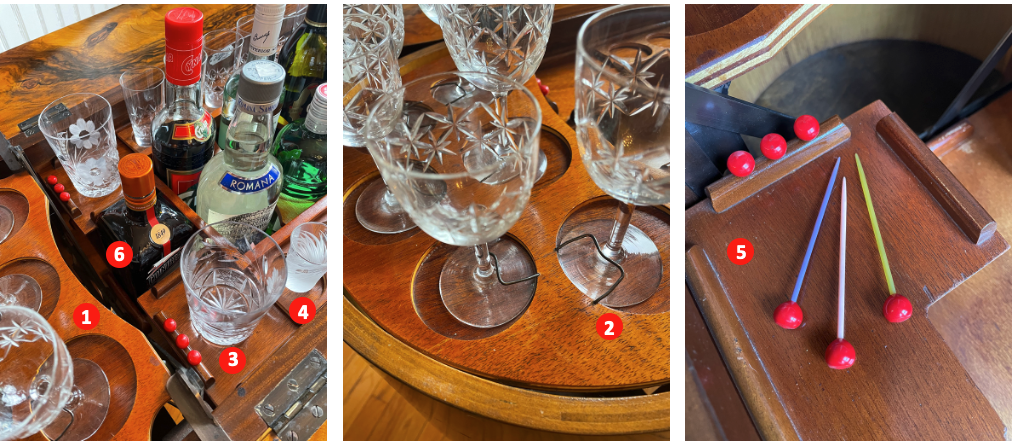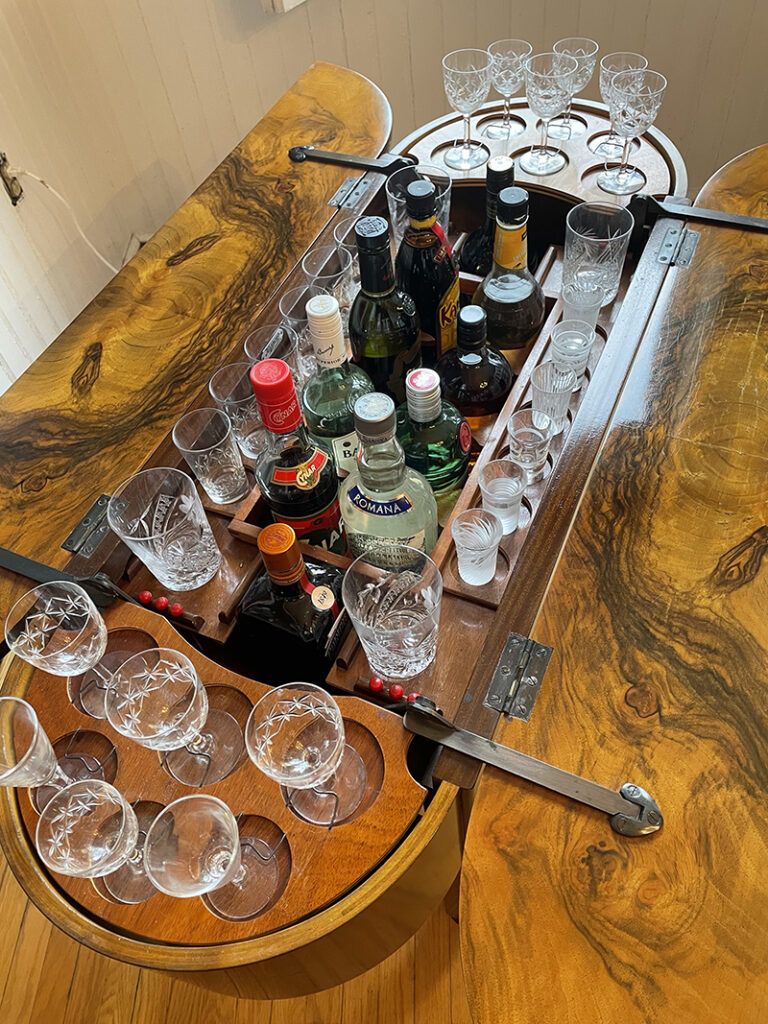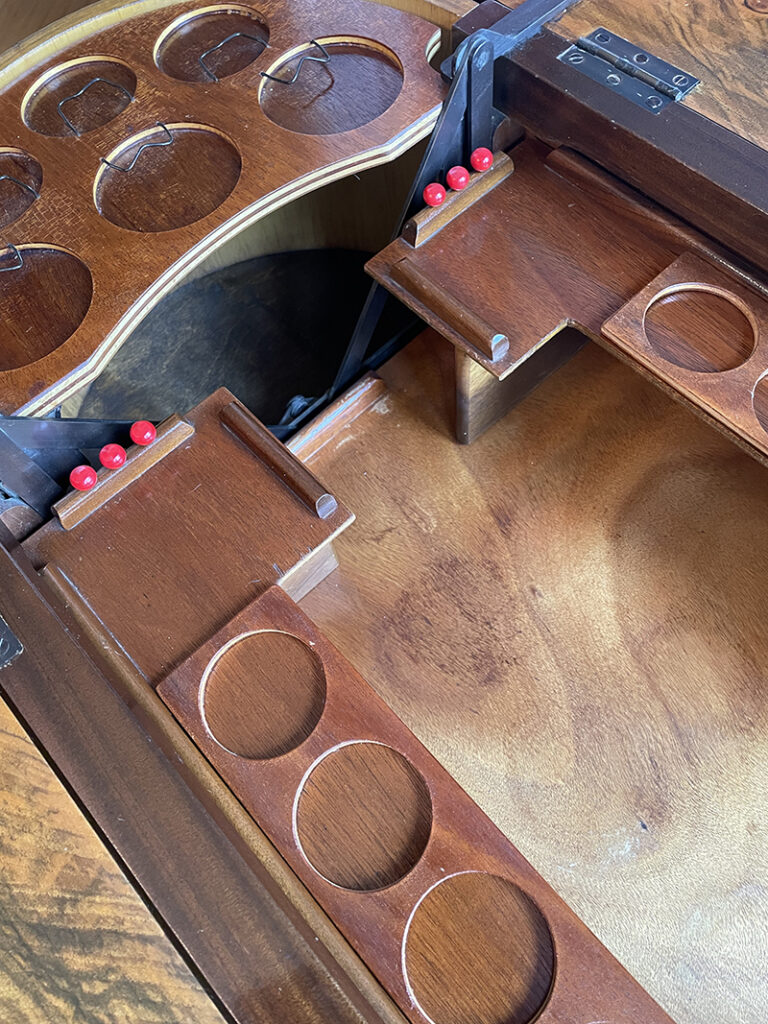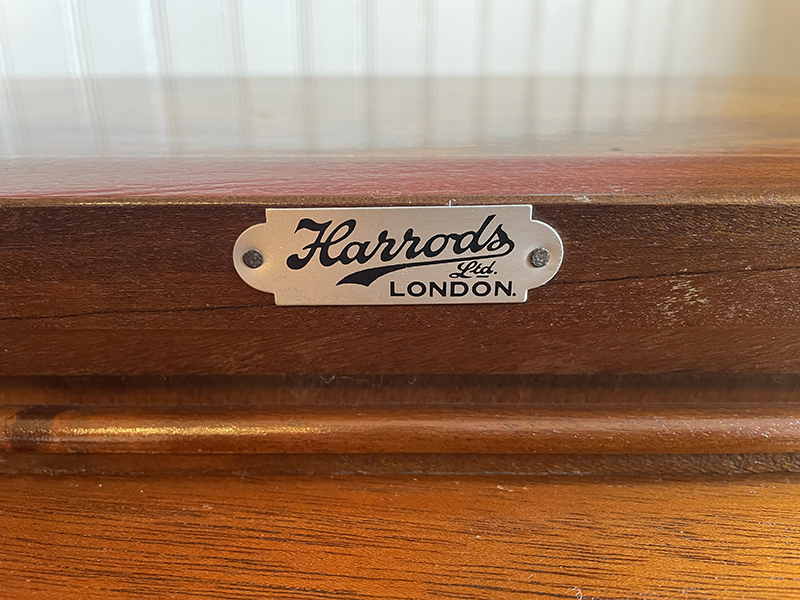
Harrods mid-century cocktail cabinet. I occasionally enjoy Campari, Aperol, or a glass of wine, but rarely liquor, with the exception of the sweet variety such as Amaretto, Cointreau, or Grand Marnier. I guess it’s because I have a sweet tooth, yet I own a cocktail cabinet and bar! And not just any cocktail cabinet.
This particular cabinet is a piece of architecture with an ingenious contraption to present bottles, crystal glasses, and sizzlers. In other words, it is an elegant interpretation of the cocktail hour in Britain, a time to impress your guest (without staff and bartender might I say), or simply kick the evening off with a drink, or end it with a nightcap following an evening of Noel Coward at the theater. (Let’s not forget that the cocktail hour was invented in America and crossed the Atlantic to became fashionable in Britain in the 1920s.)
My particular cabinet has wit, and like Coward “a sense of personal style, a combination of cheek and chic, pose and poise.” All of this provided a comforting ritual in one’s home in era before the advent of the popular happy hour offered to guests at restaurants after a long day at the office.
I acquired this piece of furniture from a former student of mine, who, after gaining his architecture degree, moved to London to study at Christie’s, the famous British auction house founded in 1766. Upon his return to Kentucky, John opened an antiques store that featured a cornucopia of furniture from Europe and the British Isles, in addition to exquisite native Kentucky pieces, ones that are now so hard to find. The cocktail cabinet he had in his store was intriguing with its elegant veneer and commanding stature. Add to that its historical perspective on the art of drinking, and I had to have it.

But in fact, what is this piece (Image 1, above)? In my mind, it is the quintessential British cocktail cabinet (commonly called drink trolley, home bar, or bar cart). This one was produced by the also quintessential department store Harrods of London between the 1920s and 1940s. Mine seems to be of the 1930s because of the style of the typographic logo in use during that period, which is discretely affixed inside the cabinet (Image 6, below).
Harrods
To better appreciate this piece of furniture, let me start with the store. Harrods is the ionic London department store located in the posh area of Knightsbridge on Brompton Road. Established first as a draper, mercer, and a haberdashery in 1849, the family business rapidly grew to become a wholesale grocery and eventually a thriving retail operation, which now is considered one of the most exceptional shopping landmarks in the world. Leading by far KaDeWe in Berlin, Gallery Lafayette in Paris, or Takashimaya in Kyoto, Harrods is a world renowned destination; an institution in its own right and a mecca for luxury shopping.
I do not have the means to afford most things at Harrods beyond the traditional British trinkets, but hands down, my fondest memories are my visits to the gourmet grocery level with its twenty- three restaurants and numerous cafes. The luxury food emporium is like the cavern of Ali Baba, with a spectacular array of cheeses and charcuterie, fish and seafood, vegetables and fruit, cut meats, and all kind of sausages hanging from copper racks overhead.
As much as I frequent Fortum and Mason while in London, often for a ceremonial high tea; Sainsbury for its minced pies; or Marks and Spencer, whose tea sandwiches can be found at their numerous affiliates in major European cities or, even better, at Heathrow airport, Harrods is hands down my favorite. Beyond holding several royal warrants, Harrods has been a trend setter and remains a point of destination for gawkers, browsers, and sophisticated high-end celebrity buyers, who in the past have purchased lions and elephants at the store.
Cabinet

Harrods luxury seems to have been subtly translated into the opulent cocktail cabinet that I own. Its basic shape has a central deep rectangle with half circle volumes at either end. Set on four legs supported by castors to be easily and elegantly moved along the floor without leaving a mark, the two elongated flaps on the top open up to reveal storage for eight bottles, two decanters, various sizes of glassware, and original wooden cocktail sizzlers in three colors.

Recessed tiers

The functionality of this cabinet is accompanied by its overall effect of surprise. The inside presentation is achieved by opening the bar simply by raising both flaps, letting the assortment of bottles slowly emerge as the cantilever spring mechanism lifts.
On the three tiers (Image 4, above), the first one provides round cut outs (1), which we use to secure port or sherry glasses beneath the little metal hooks (2), followed on the second level by a slightly recessed tray at the four corners where we have whiskey tumblers (3). Alongside these are surface with cut-out circles for six smaller glasses (4), and holes for a set of twelve Bakelite sizzlers of three different colors with spherical candy-red tops (5). Finally, the lowest tier, which necessitates the depth of the cabinet, houses ten liquor bottles (6).
Contraption

Each of the elements (1 to 6) move up and down as one simultaneously opens or closes both cabinet cover flaps (Image 5, above). When fully opened, the inside veneered surfaces of the cover provide ample space to set an ice bucket, shaker, and various small dishes for olives and lemons, all the while leaving room to mix drinks with great panache on the other side.
Each corner of the central rectangle contains a moving mechanism that works best when the liquor cabinet is fully stocked, meaning weighted.
Conclusion

It’s amazing that after a century of use and travel across the Atlantic, this rather rare mid-century cocktail cabinet is in excellent condition and operates smoothly. Any minor scratches could easily be cleaned and polished—if only I had the time and the know how to treat the surface appropriately. While the cabinet stays closed for extended periods of time, its top surface provides room for seasonal decoration, while remaining for many guests an unknown object of curiosity.

General information
Height: 32″
Width: 45” full length
Depth: 16.5” closed, xxx open
Period: early 20th century (c. 1930)
Style: British
Wood: oak veneer for the inside with mahogany veneer for the entire outside and inside flaps
Additional curiosities from portraits of a collection
Images















